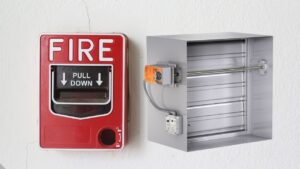Fire safety maintenance is a crucial aspect of building management that should never be overlooked. It involves regular inspections, checks, and maintenance of fire safety systems and equipment to ensure they are in proper working order. The importance of fire safety maintenance cannot be overstated, as it plays a vital role in preventing fires, minimizing damage, and saving lives.
Key Takeaways
- Regular inspections and checks are crucial for fire safety maintenance.
- Understanding fire safety regulations and standards is important for identifying potential hazards.
- Routine fire safety inspections should be conducted to ensure compliance and safety.
- Maintaining fire detection and suppression systems is a key component of fire safety maintenance.
- Developing a comprehensive fire safety maintenance plan can prevent disasters and save lives.
Importance of Regular Inspections and Checks
Regular inspections and checks are essential for fire safety maintenance because they help identify potential issues before they become major problems. By conducting routine inspections, building owners and managers can ensure that fire safety systems and equipment are functioning correctly and are up to code.
Neglecting fire safety maintenance can have severe consequences. In the event of a fire, malfunctioning or poorly maintained fire safety systems can fail to detect the fire or activate the necessary alarms and suppression systems. This can lead to delayed response times, allowing the fire to spread rapidly and causing more significant damage. Additionally, non-compliance with fire safety regulations can result in legal consequences, fines, and even closure of the building.
Understanding Fire Safety Regulations and Standards
Buildings must comply with specific fire safety regulations and standards to ensure the safety of occupants. These regulations vary depending on the location and type of building but generally include requirements for fire detection and alarm systems, fire suppression systems, emergency exits, evacuation plans, and more.
Non-compliance with fire safety regulations can have serious consequences. In addition to the potential loss of life and property in the event of a fire, building owners may face legal repercussions such as fines or even criminal charges. It is crucial for building owners and managers to stay informed about the applicable regulations and standards in their area and ensure that their buildings meet or exceed these requirements.
Identifying Potential Fire Hazards in Buildings
Identifying potential fire hazards is an essential part of fire safety maintenance. By recognizing these hazards, building owners and managers can take proactive measures to mitigate the risk of a fire. Common fire hazards in buildings include faulty electrical wiring, overloaded power outlets, flammable materials, blocked fire exits, improper storage of chemicals, and more.
To identify potential fire hazards, regular inspections should be conducted throughout the building. Look for signs of electrical issues such as flickering lights or burning smells. Check for cluttered areas or improper storage of flammable materials. Ensure that fire exits are clear and accessible. By being vigilant and proactive in identifying potential fire hazards, building owners and managers can take the necessary steps to eliminate or minimize these risks.
Conducting Routine Fire Safety Inspections
Routine fire safety inspections are crucial for maintaining the overall safety of a building. These inspections should be conducted by trained professionals who are knowledgeable about fire safety regulations and standards. During an inspection, all fire safety systems and equipment should be thoroughly examined to ensure they are in proper working order.
In addition to professional inspections, building owners and managers should also conduct regular self-inspections to identify any potential issues between professional visits. This can include checking fire extinguishers for proper pressure and expiration dates, testing smoke detectors and alarms, inspecting emergency lighting systems, and ensuring that fire exits are clear and unobstructed.
Key Components of Fire Safety Maintenance
Fire safety maintenance encompasses several key components that work together to ensure the overall safety of a building. These components include:
1. Fire Detection and Alarm Systems: These systems are designed to detect the presence of a fire and alert occupants to evacuate the building. Regular maintenance is essential to ensure that smoke detectors, heat detectors, and alarm systems are functioning correctly.
2. Fire Suppression Systems and Equipment: Fire suppression systems, such as sprinkler systems or fire extinguishers, are crucial for controlling or extinguishing fires. Regular maintenance ensures that these systems are operational and ready to respond in case of a fire.
3. Emergency Exits and Evacuation Plans: Emergency exits should be clearly marked, unobstructed, and easily accessible. Evacuation plans should be posted throughout the building, and regular drills should be conducted to ensure that occupants are familiar with the evacuation procedures.
4. Electrical Systems: Faulty electrical systems can be a significant fire hazard. Regular inspections and maintenance of electrical wiring, outlets, and appliances are essential to prevent electrical fires.
5. Fire Safety Training: Building occupants should receive proper fire safety training to know how to respond in case of a fire. This includes knowing how to use fire extinguishers, understanding evacuation procedures, and being aware of potential fire hazards.
Maintaining Fire Detection and Alarm Systems
Maintaining fire detection and alarm systems is crucial for early detection of fires and timely evacuation of occupants. Regular maintenance should include testing smoke detectors, heat detectors, and alarm systems to ensure they are functioning correctly. Batteries should be replaced regularly, and any faulty or malfunctioning components should be repaired or replaced immediately.
Building owners and managers should also ensure that all occupants are familiar with the sound of the fire alarm and know how to respond when it is activated. Regular drills should be conducted to practice evacuation procedures and ensure that everyone knows how to exit the building safely.
Maintaining Fire Suppression Systems and Equipment
Fire suppression systems, such as sprinkler systems or fire extinguishers, are essential for controlling or extinguishing fires. Regular maintenance is crucial to ensure that these systems are operational when needed.
Sprinkler systems should be inspected regularly to ensure that all sprinkler heads are free from obstructions and functioning correctly. Fire extinguishers should be checked for proper pressure, expiration dates, and any signs of damage or wear. Any issues with these systems or equipment should be addressed immediately to ensure their effectiveness in case of a fire.
Developing a Comprehensive Fire Safety Maintenance Plan
Developing a comprehensive fire safety maintenance plan is essential for ensuring that all aspects of fire safety are properly addressed. This plan should include a schedule for routine inspections and maintenance, as well as guidelines for addressing any issues that arise.
The plan should also outline the responsibilities of building owners, managers, and occupants in maintaining fire safety. It should include procedures for reporting potential fire hazards, conducting self-inspections, and ensuring that all occupants receive proper fire safety training.
Benefits of Regular Fire Safety Maintenance and Inspections
Regular fire safety maintenance and inspections offer numerous benefits. By identifying and addressing potential fire hazards, building owners and managers can significantly reduce the risk of a fire occurring. This not only protects the lives of occupants but also minimizes property damage and financial losses.
Additionally, regular maintenance ensures that fire safety systems and equipment are in proper working order. This means that in the event of a fire, these systems can respond quickly and effectively, minimizing the spread of the fire and allowing for timely evacuation.
Fire safety maintenance is a critical aspect of building management that should never be overlooked. Regular inspections, checks, and maintenance of fire safety systems and equipment are essential for preventing fires, minimizing damage, and saving lives. By understanding fire safety regulations and standards, identifying potential fire hazards, conducting routine inspections, maintaining key components of fire safety, and developing a comprehensive maintenance plan, building owners and managers can prioritize fire safety in their buildings. It is crucial to recognize the importance of regular fire safety maintenance and take proactive measures to ensure the overall safety of occupants and property.
FAQs
What is fire safety maintenance?
Fire safety maintenance refers to the regular inspection and checks of fire safety equipment and systems to ensure they are in good working condition and can effectively prevent, detect, and extinguish fires.
Why is fire safety maintenance important?
Fire safety maintenance is important because it helps to prevent fires and minimize their impact. Regular inspections and checks ensure that fire safety equipment and systems are functioning properly and can be relied upon in the event of a fire.
What are some examples of fire safety equipment and systems that require maintenance?
Examples of fire safety equipment and systems that require maintenance include fire alarms, sprinkler systems, fire extinguishers, emergency lighting, smoke detectors, and fire doors.
How often should fire safety equipment and systems be inspected?
The frequency of inspections depends on the type of equipment and system. For example, fire alarms and sprinkler systems should be inspected annually, while fire extinguishers should be inspected monthly.
Who is responsible for fire safety maintenance?
The responsibility for fire safety maintenance typically falls on the building owner or manager. However, tenants and employees also have a responsibility to report any issues or concerns related to fire safety equipment and systems.
What happens if fire safety equipment and systems are not properly maintained?
If fire safety equipment and systems are not properly maintained, they may not function properly in the event of a fire. This can result in property damage, injuries, and even fatalities. Additionally, failure to properly maintain fire safety equipment and systems can result in legal and financial consequences.









